-
Posts
3,489 -
Joined
-
Last visited
Content Type
Profiles
Forums
Gallery
Events
Posts posted by Cathead
-
-
Ken, I've considered that approach. I've seen it used elsewhere and my club layout will be doing that in various settings. I think for the windmill it wouldn't make sense for a couple of reasons. One, if you look at its height, it's way taller than a railroad signal, it would be closer to 4-5" and that'd be a very tall and distracting plexiglass panel, even clear. Just as likely to catch an elbow as the windmill itself. Two, while signals obviously have to be in place along the line and thus need protection, a windmill is just a scenic highlight and could easily be removed during operations with no loss. So I think that's the easier answer in this case.
-
Yes, of course horses don't "need" permanent ramps to be loaded onto rail cars. That photo shows the German army loading horses into rail wagons during World War 2, a very different context than peacetime racehorse handling.
What I'm trying to get at is that this barn isn't anywhere near big or developed enough to be an organized shipper/receiver of horses by rail, and there's no history of that happening in this area. If you DID plan on routinely handling horses on/off trains at a single location, you WOULD build a permanent loading structure that was more stable (no pun intended) and safe for the routine handling of high-value animals. This is why all railside stockyards had permanent loading chutes with strong rails, etc., including the one in Rocheport east of the depot. And horses are a lot more valuable, per unit, than cattle.
It's entirely possible that this wealthy guy's barn occasionally shipped or received a horse, whether he bought one from a high-end stable or did some breeding himself. But if so, he likely would have done so using a temporary ramp on a siding where a car could be left (such as near the depot) because the railroad wouldn't stop a train or leave a car on the mainline just for a horse, or possibly he would have used the actual stockyard ramp with its permanent, safe infrastructure for loading livestock into railcars.
Finally, if you were shipping racehorses or high-end breeding stock across the country, the Katy's line across Missouri is about the last route you would choose. As discussed early in this log, it was late-coming to east-west lines across the state and at least two other routes between St. Louis and Kansas City were straighter, faster, and more established. The Katy's line was more roundabout in route, was relatively slow, and wouldn't have been economically competitive for this kind of fast, high-value freight. Even if you were shipping down to Texas, where the Katy was a lot more competitive, you'd probably route the car by a different railroad like the Missouri Pacific as far as Sedalia and then transfer the car/horse south from there on the Katy. You may have to trust me on this one if you don't really want to go into the weeds of 1900s-era rail networks.
The point is that I don't think there's any operational connection between this horse barn and the railroad. If it was meant to be served directly by the railroad in any meaningful way, it would be on the siding, not along the main line. I love the enthusiasm, but I think the simple answer is sufficient. It's just a local horse barn, however attractive!
- Jack12477, Paul Le Wol, Rik Thistle and 3 others
-
 6
6
-
Well, there's no question it's a barn, and all livestock need fresh pasture. This is exactly what a horse barn/stable would look like. I just think it's for the local use of a local owner, not tied to the railroad or any kind of shipping. Anyone who keeps horses, in 1900 or now, has a barn with attached paddock to allow exercise and fresh air. I'd also say that those rail fences are very typical for horses, then and now.
I'd say no to sheep because (a) sheep have never been a big thing in this part of Missouri and (b) they're not high-value enough to justify a fancy barn and rail fence like that. Again, it's exactly what a moderately wealthy horse owner would construct.
-
1 hour ago, Canute said:
Needed heat tape wrapped around the water hydrant in the winter
Speaking of water, notice the tall windmill just behind this barn in the historic photo. I assume it's there to guarantee a non-river water supply to Mr. Merchant's horse barn. That's a detail I'll also enjoy adding, though it WILL have to be removable for operating sessions! That's a guaranteed elbow-catcher.
- Keith Black, Jack12477, Canute and 2 others
-
 5
5
-
Keith, that's a fun idea, but a few factors argue against it. One, there's no loading ramp or other access point visible. Two, it's on the main line side, not the siding, and it's unlikely the railroad would spot a stock car blocking the main, or stop a mainline train to wait for a horse to be (un)loaded. Three, Rocheport is a very minor location between a variety of larger towns/cities that would have been better settings for such an arrangement. No trains would have stopped here overnight. For example, Franklin (only ten miles west) had much larger railroad facilities as the division point and would have been a much more convenient setting for such an arrangement if it ever happened. Same for Sedalia further southwest. But I appreciate you sharing the idea, it's always good to have more than one brain thinking about a question!
- Paul Le Wol, Jack12477, Keith Black and 2 others
-
 5
5
-
Back to scratch-building! This is a fun project I've been looking forward to, another one of those "keystone" buildings that define the setting as Rocheport, along with the depot and the elevator. Check out the distinct Spanish-style white barn in the photo below, looking east from atop the tunnel's ridge. It's right along the tracks and really stands out among the other, more typical structures. I've known from the beginning that I wanted to build this.
Closer view below. It's just such a unique structure. I wish I knew who decided to build this fancier barn here in this part of town, where it's more flooding-prone and buildings are generally simpler. Compare with the perfectly utilitarian small-farm barn just to the foreground of it. I'm thinking this one is a horse stable for a leading citizen, like a banker or merchant.
Time to build! I made a central frame of wooden sheets for structural strength. No windows or open doors (with one minor exception) will pierce this, so I didn't need to worry about what the interior looked like. I designed the dimensions by roughly measuring the ratios off the photo, and comparing to what would fit in the dedicated spot on the layout. It came out close enough that only minor compression was needed (which led to one oopsie that you'll notice later on).
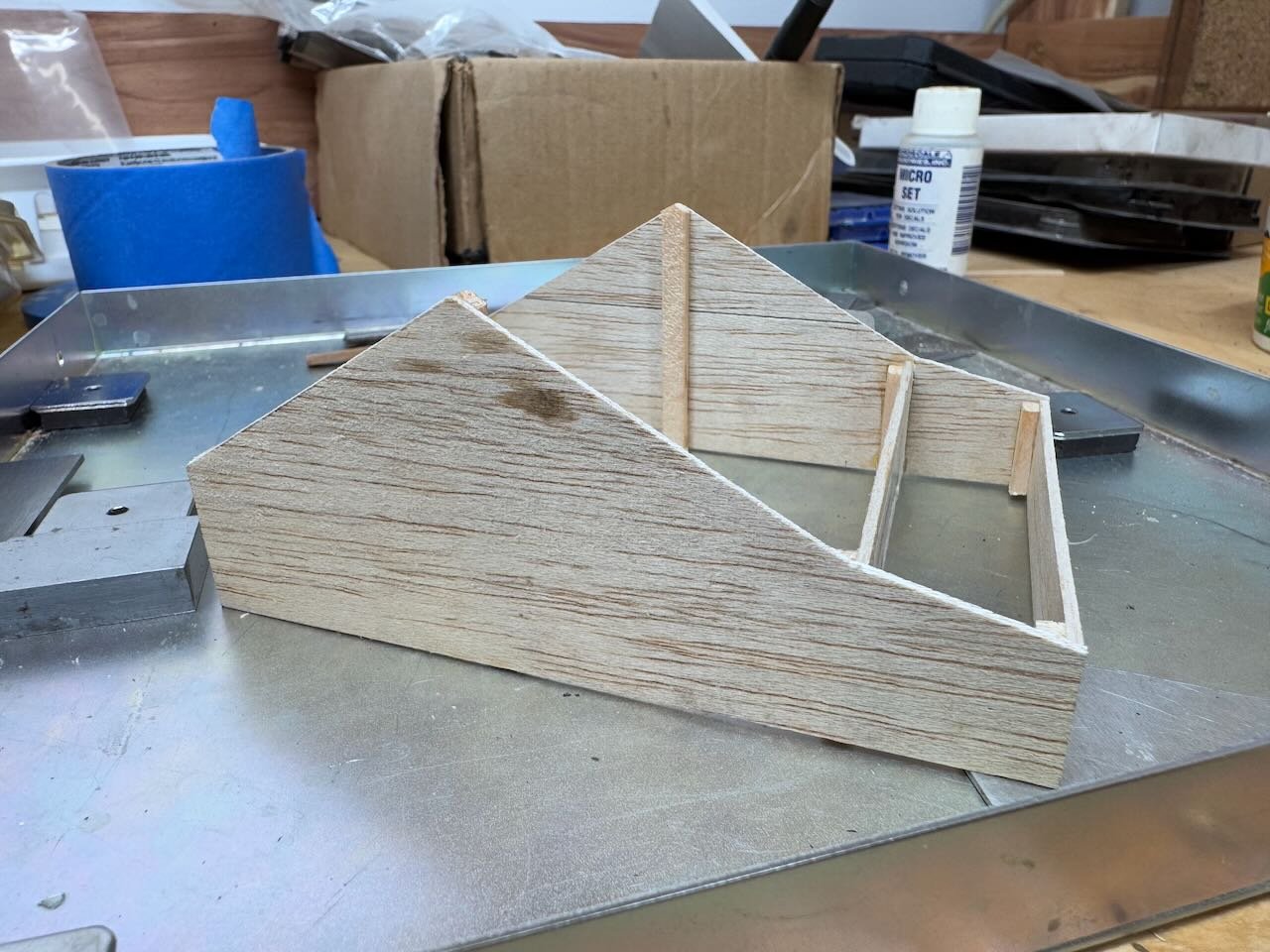
With the central core done, I sheathed it in wood pre-scribed in a board-and-batten style. I couldn't quite tell how the real barn was sheathed, but as this was a fairly fancy structure for a barn, I decided it would have this more tightly sealed style than just regular boards. All doors will be plastic items scavenged from my scrap box to be both close enough to the real thing, and to look right on a barn. So I cut slots in the siding as needed, to accept these insets.
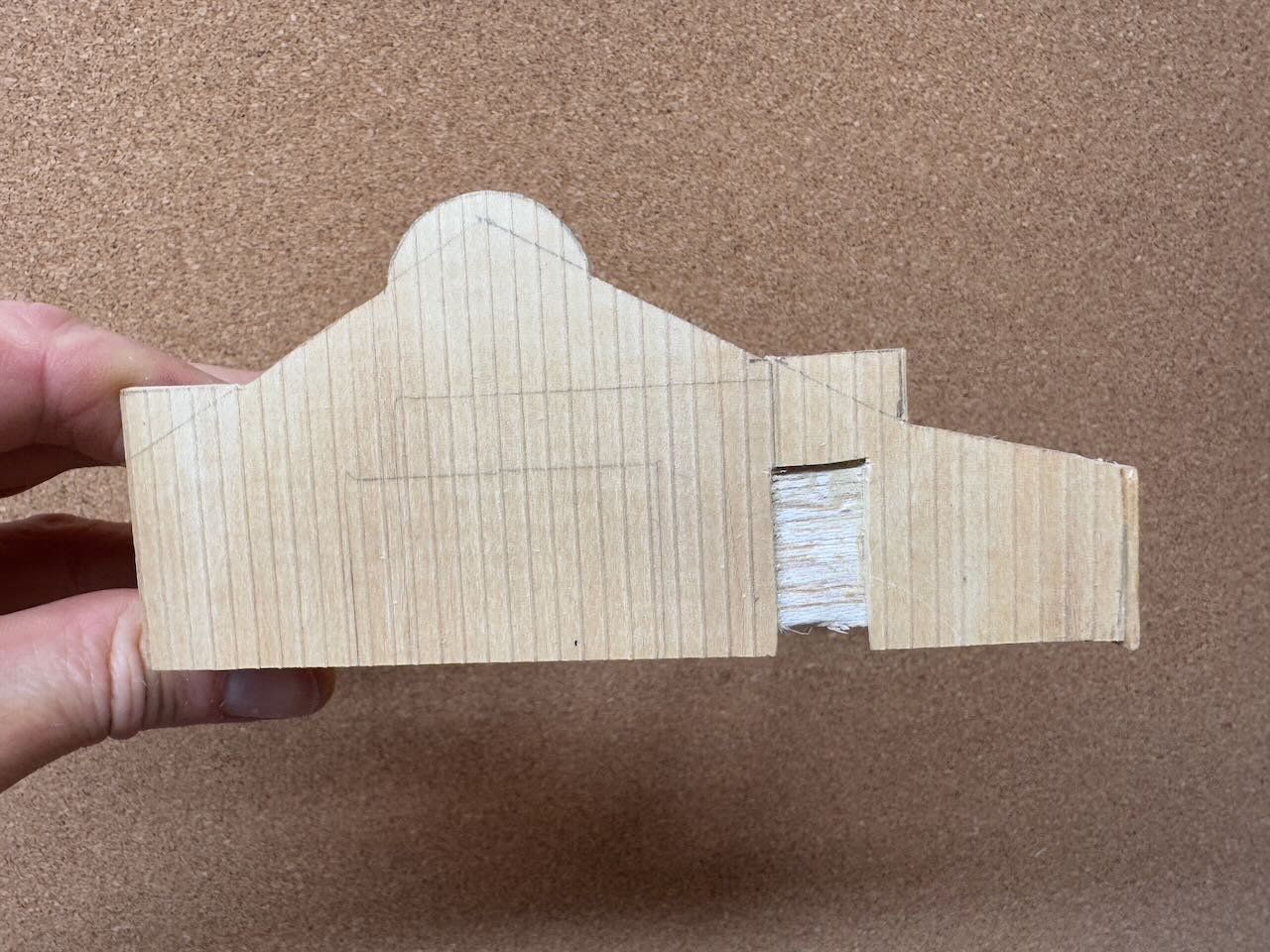
When I was happy with the siding pieces, I glued them on real good. View below shows the other side. I have no photos from this direction, so used a different style of main door that I'll discuss further below.
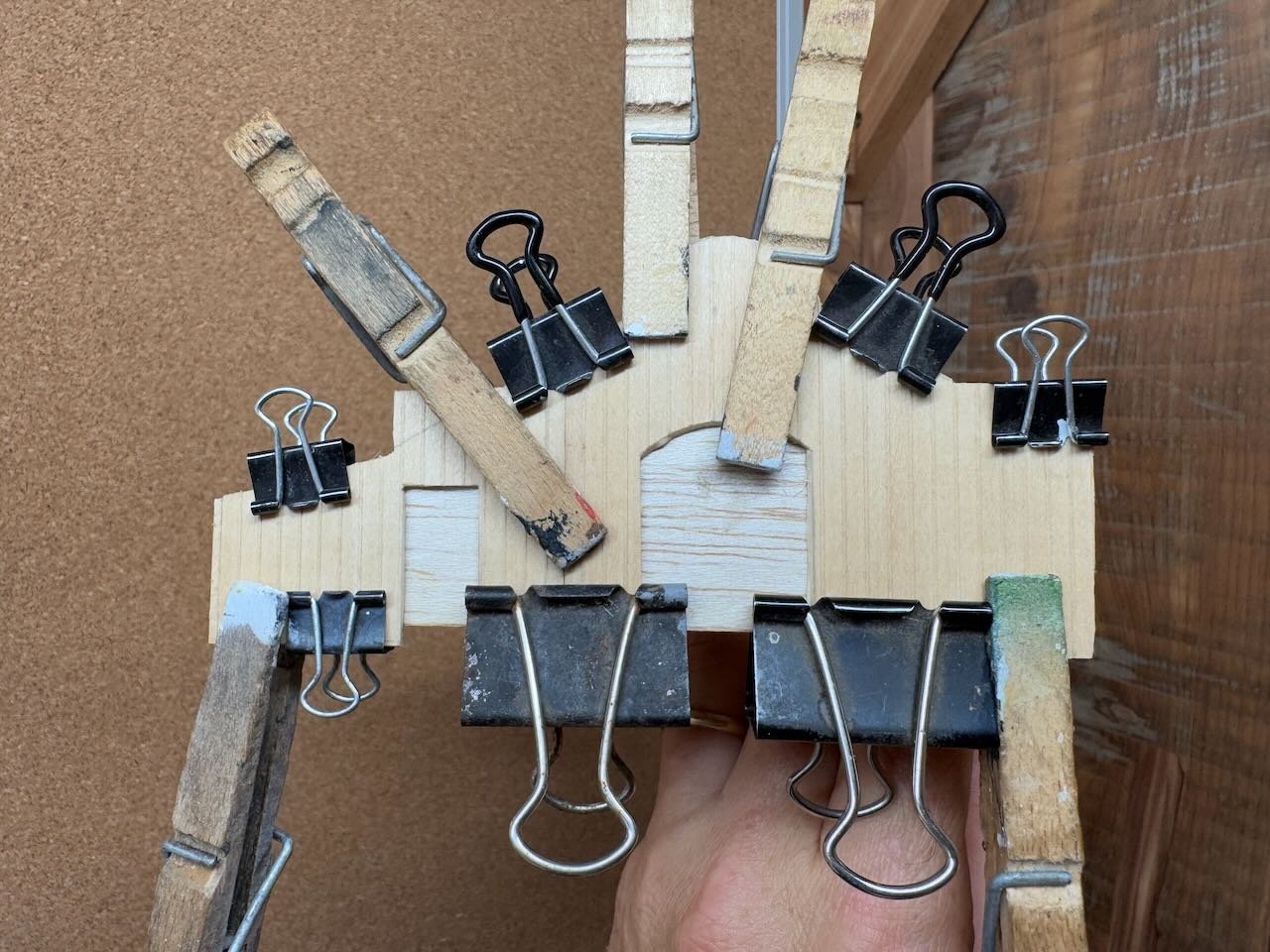
With all the siding attached, I airbrushed it an off-white. Didn't want it too shiny, it's still a barn.
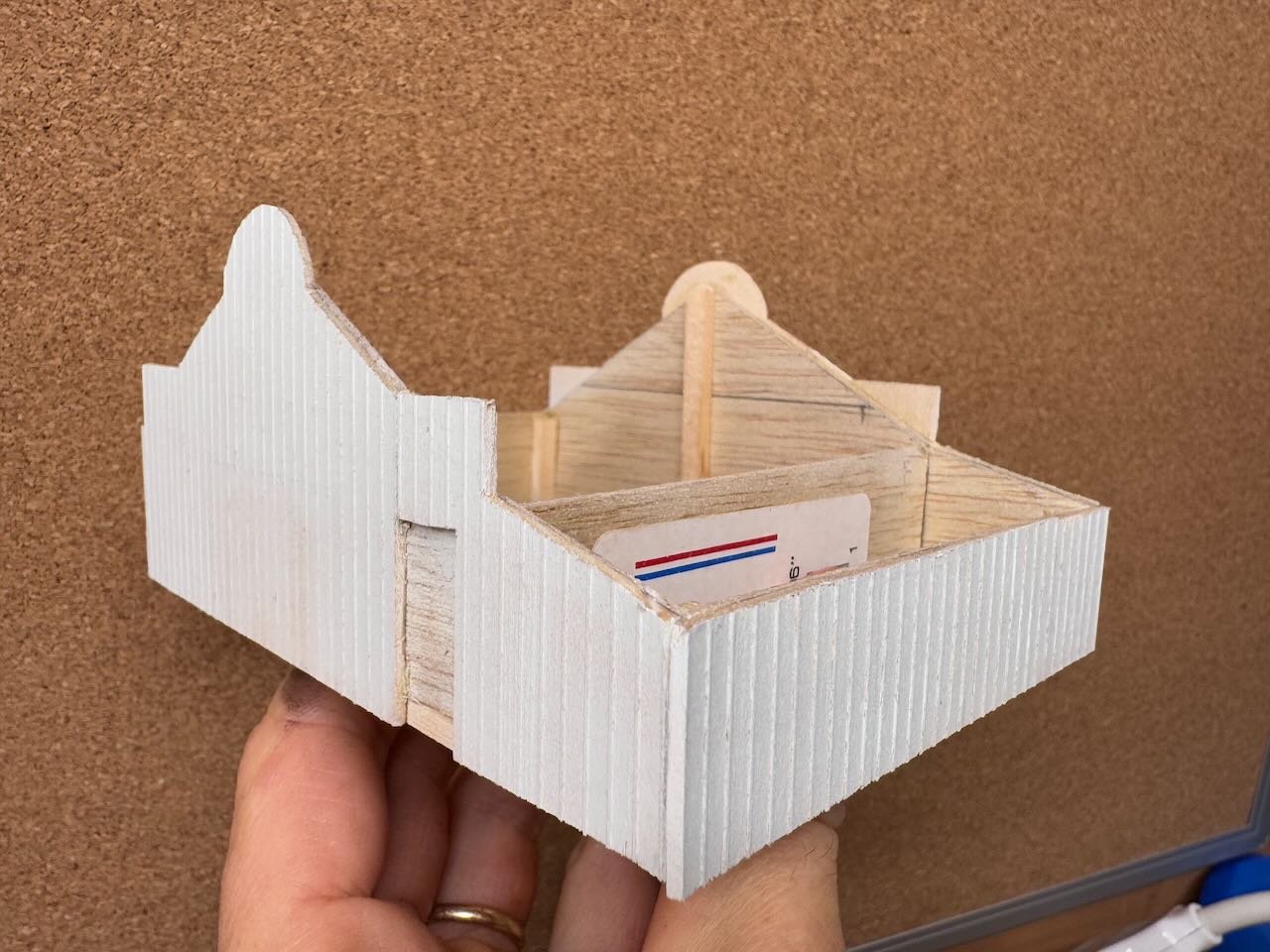
Next up was to design and cut the roof pieces. Slightly more complicated than usual since the central part fits within the fancy walls, while the outer shed just extends like normal but is wider. And there's a change in roof angle between the two parts.
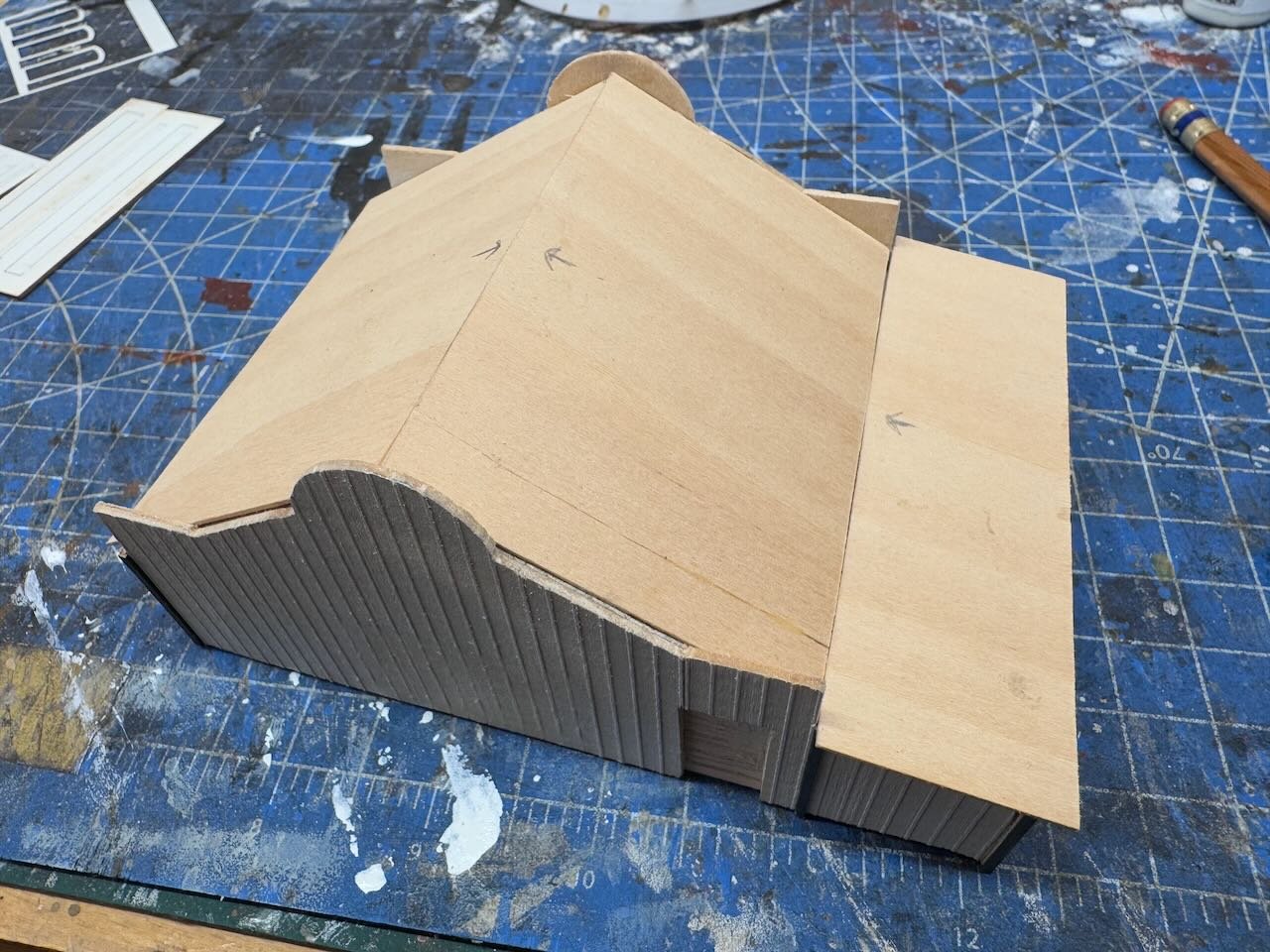
These are thin sheets, so I braced them underneath to avoid warping. Below is a view showing that, and the beginning of shingle application.
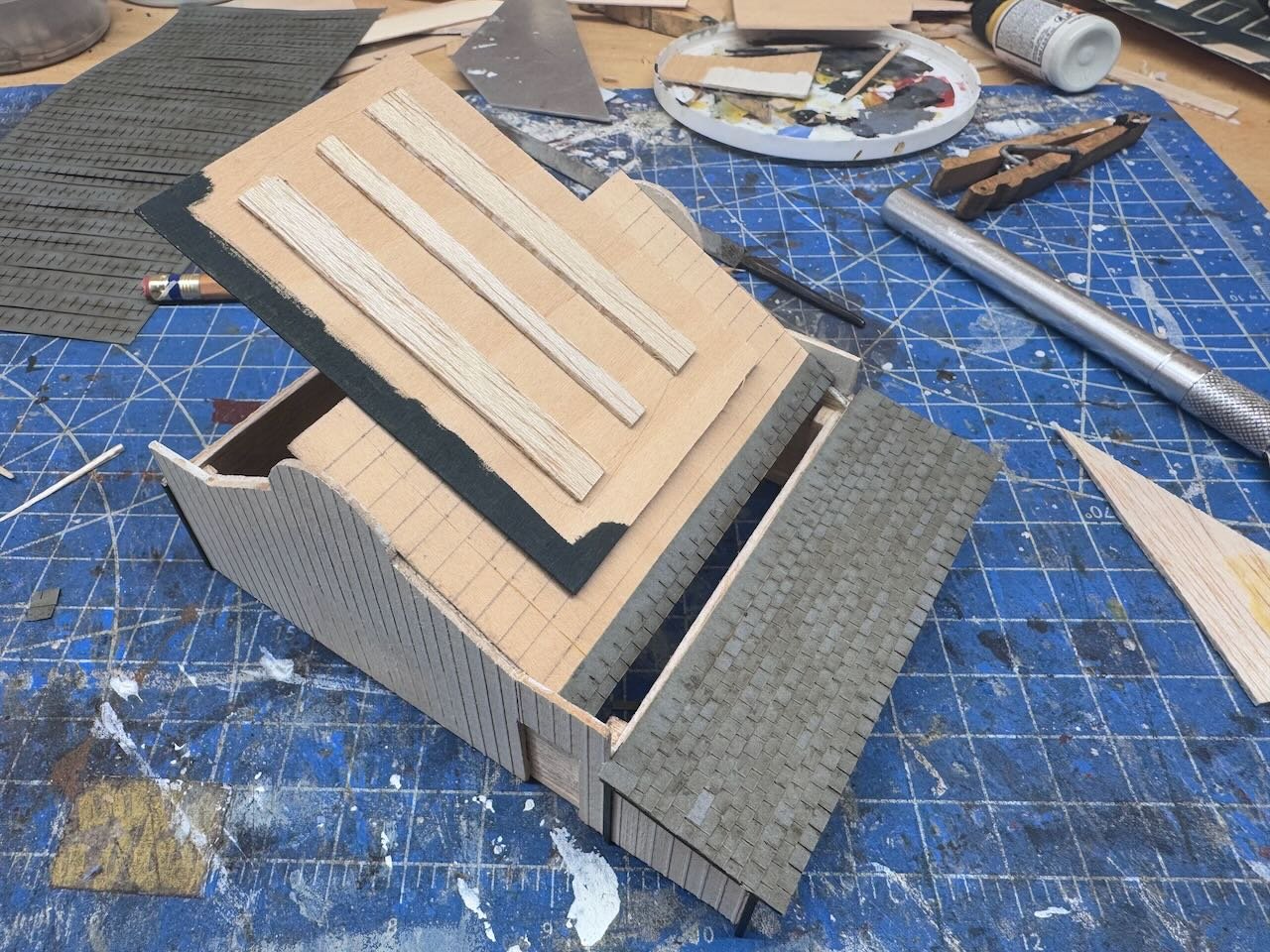
These shingles are tedious to apply, but look wonderful. I like to do these off-model, so I can leave overhangs at each end of the roof and trim them consistently. This created a challenge in this particular build, because I needed to make the transition between two roof angles (and thus pieces) but couldn't lay a transition strip over this between the projecting walls because I needed to lay shingles off-model. So what I did was lay the first set of shingles on the upper roof with half of the shingle line extending past the wood, such that when the finished roof piece was installed, they'd naturally overlap the lower roof. The image below shows what that looks like in a test-fit; the overlapping shingles are in the right place and will snug down nicely once these pieces are glued into place.
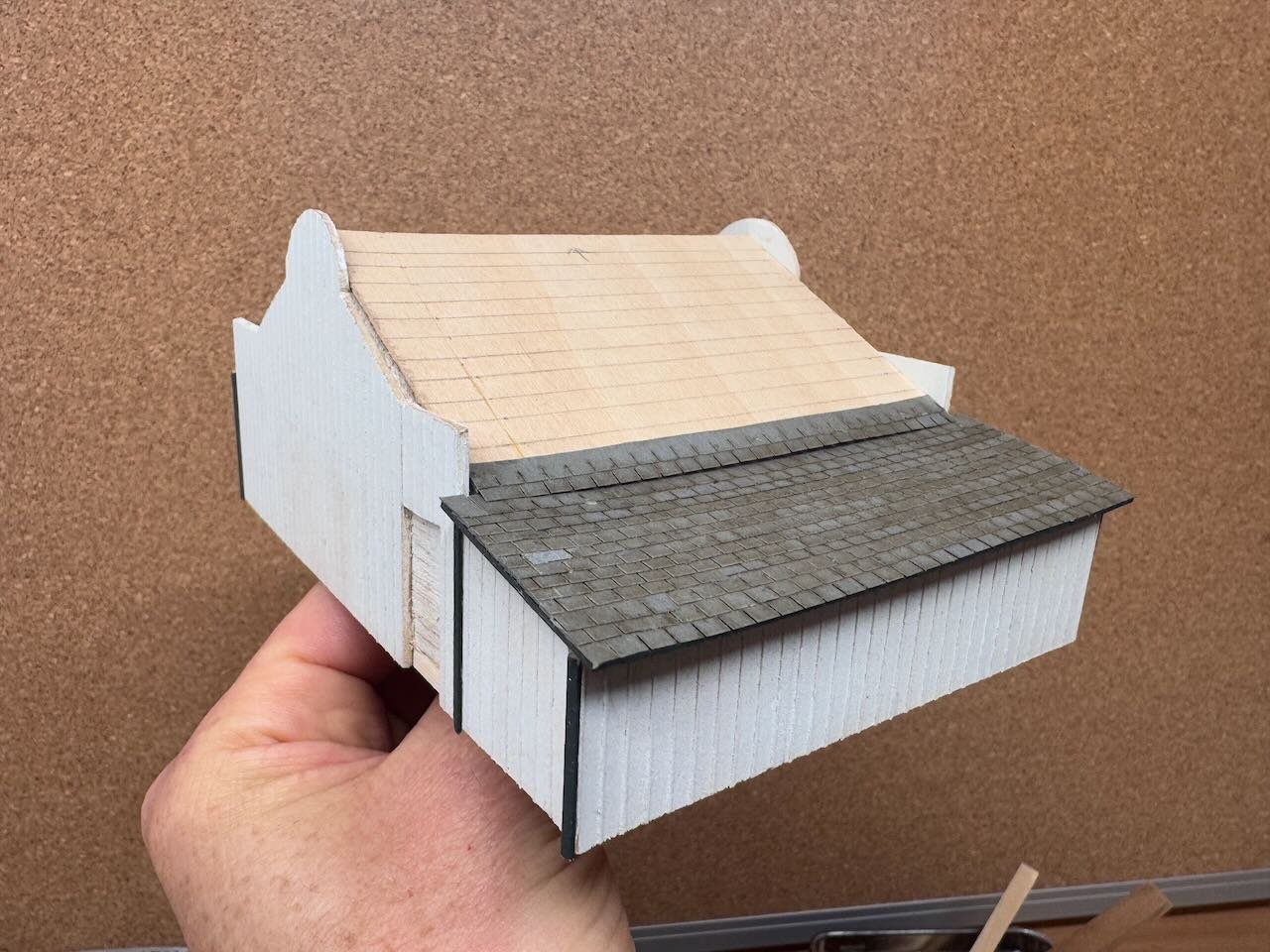
Once all the roof pieces were shingled and the glue drying (great task while half-watching a hockey game), I started working on the final trim. First, simple strips at the corners and joints between parts of the barn, like this.
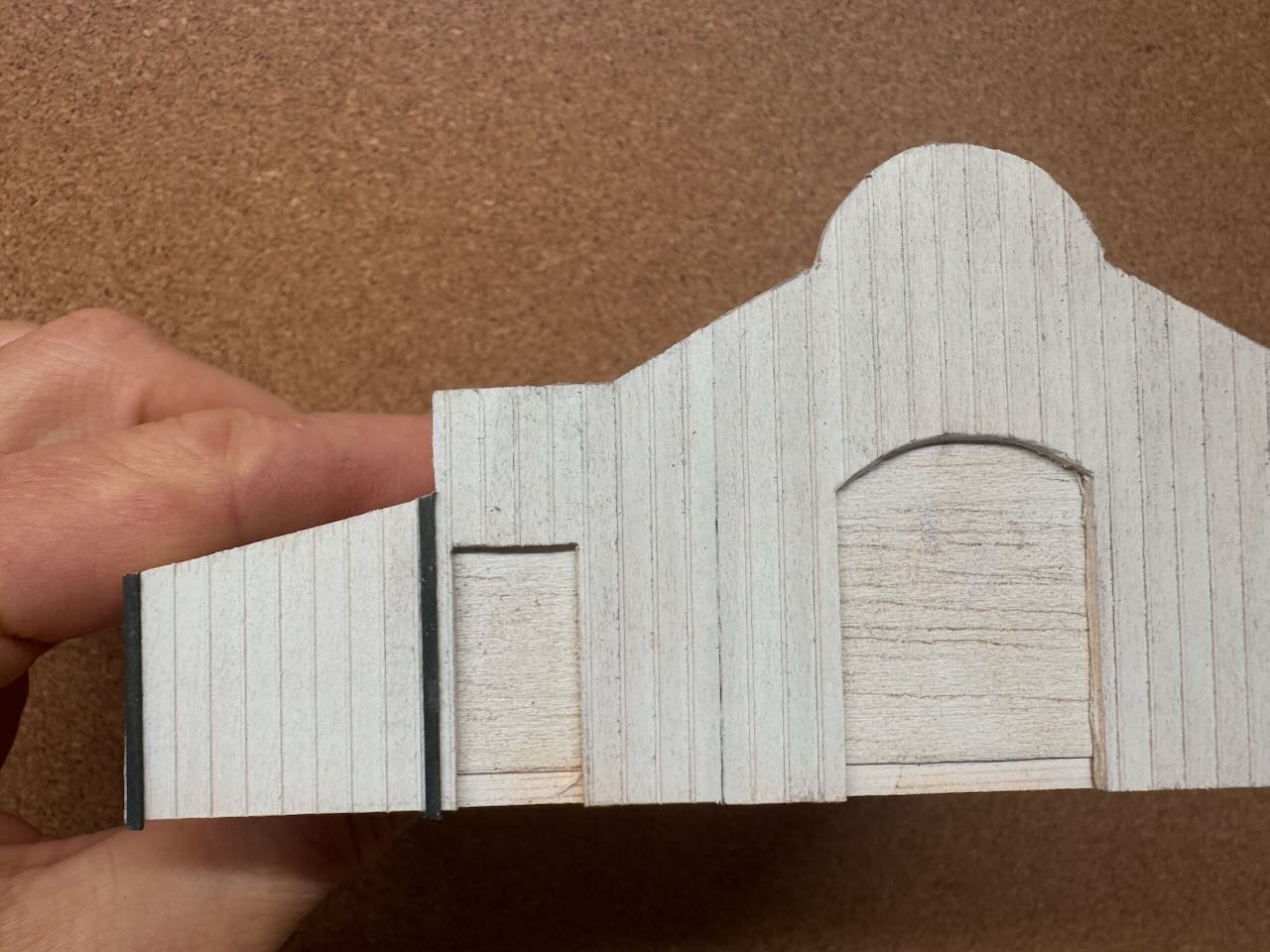
But if you were wondering, model ship-building skills came in very handy for that curved arch at either end of the roof. I cut some thin strips, soaked them, and bent them over a bottle of the right dimension, then left them near the wood stove to dry. Worked perfectly. I stopped taking photos at this point because I was too focused and having too much fun.
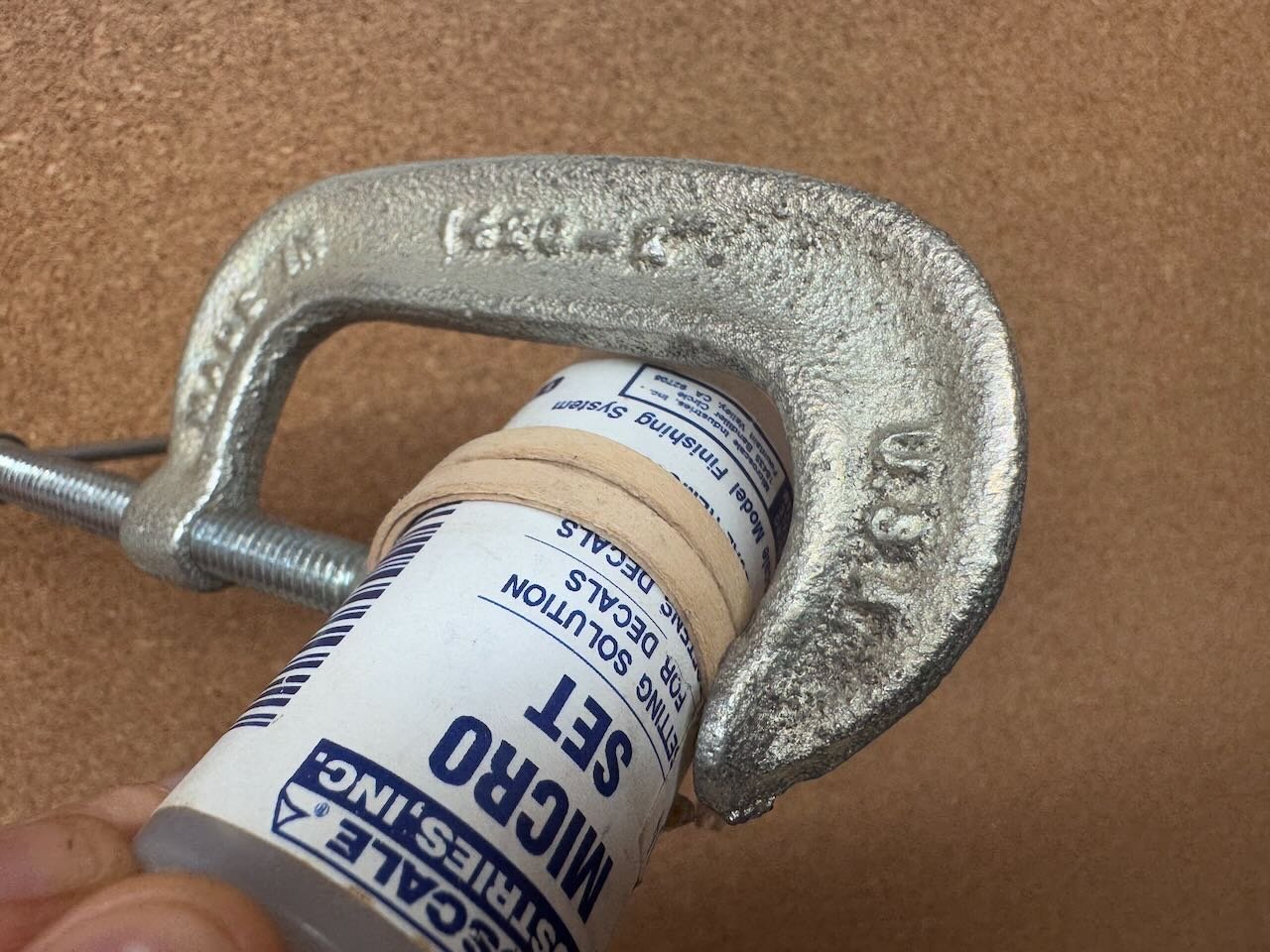
So here's the final barn. The siding is lightly weathered with pastels to give some variation to the siding, and I added subtle scrape marks where the sliding doors move against the walls.
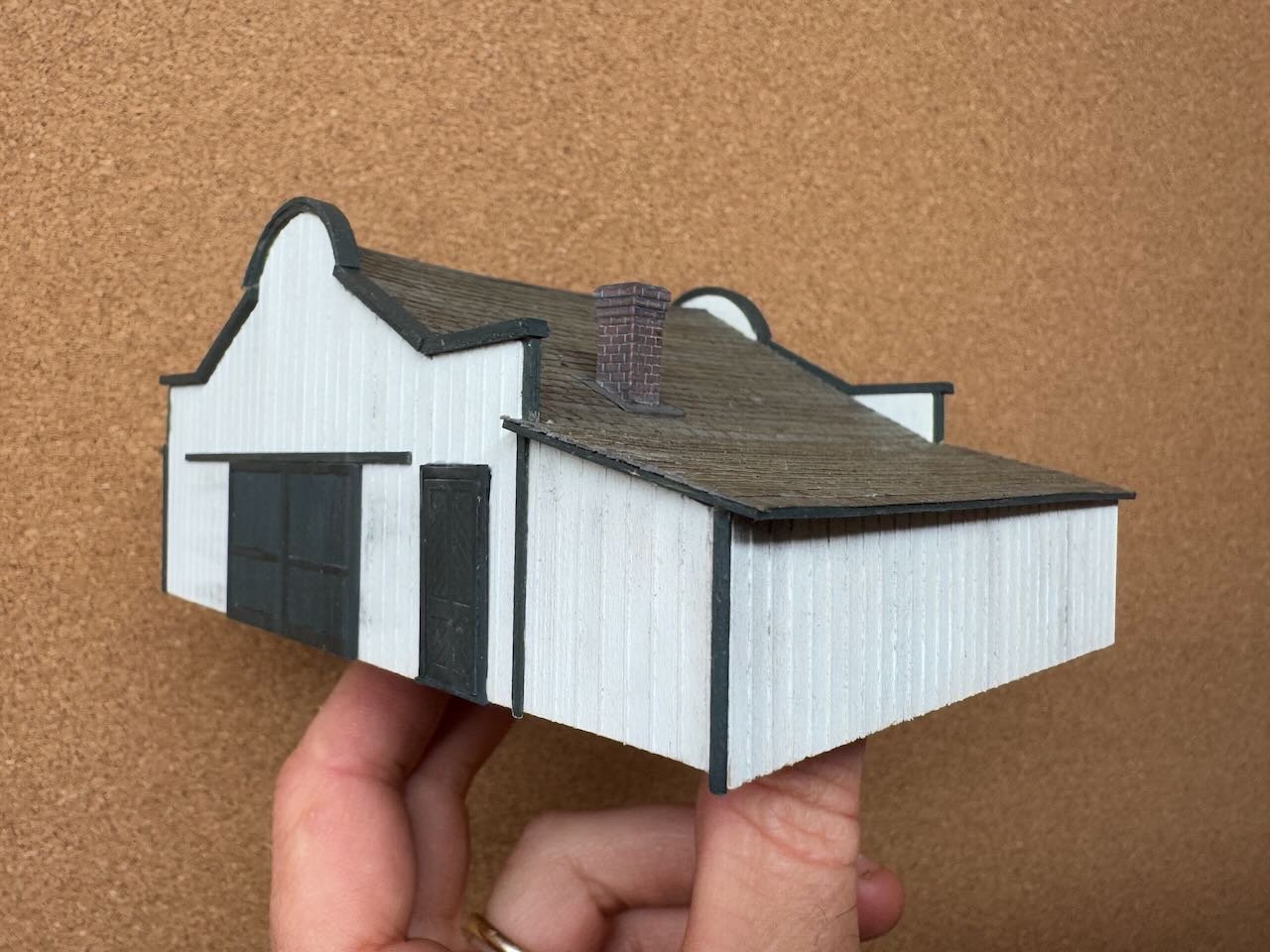
Sharp eyes will notice the compression goof in the wall above. The original barn has two sliding doors that move to either side. I didn't account for the full sliding width when I compressed the building, so the right-hand one only has room to open halfway. Oopsie. I'm considering it an Easter egg for the observant.
Below is the other side. As I said above, I didn't have any photos from this side. Arguably it would have made sense to use the same style doors on both sides, but I didn't have two more of those barn doors in my scrapbox, and I did have this very attractive stable-style curved door, which really seemed to fit the barn's style. So that's what I used here and I'm quite pleased with the look. The slotted windows above are the only penetration of the walls, but they're so narrow I just mounted them against black-painted interior wood and glazed them.
Thought I can't tell what color the original trim was, I like this green-black color that helps the barn stand out from any other structures but still has a darker palette that fits the overall theme of the layout. And it just feels classy to me.
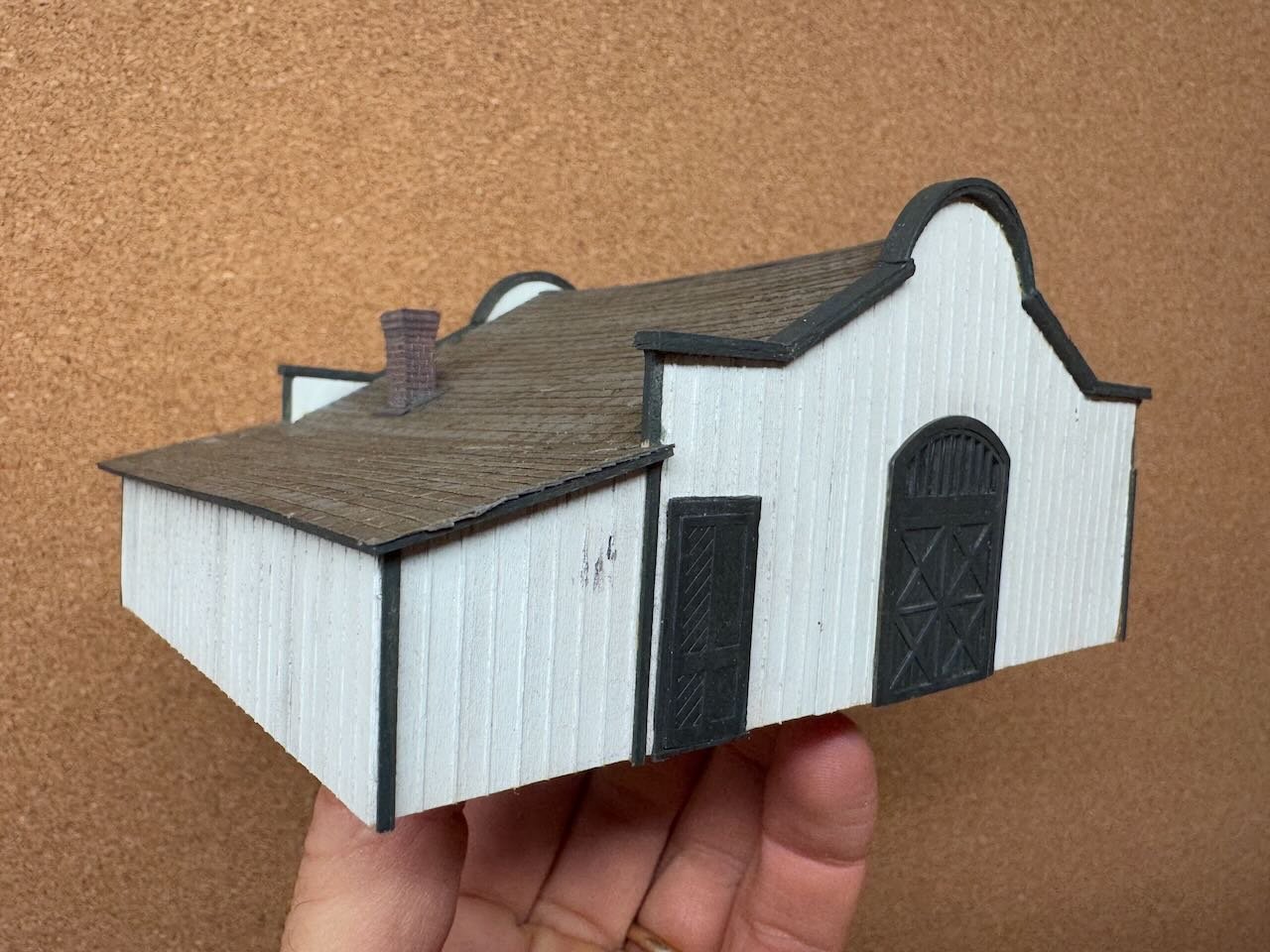
Below is the view from the side that faces the aisle. This shows an unintentional effect that turned out wonderfully. Despite interior-bracing the roof sheets, the collective moisture of the glue used to attach the shingles warped the sheets anyway. But as it turned out, that gave the roof a delightful sag that's just off-square enough to give an extra sense of realism. I don't think I could have done this better if I'd tried. It's pretty subtle unless you're looking directly from this angle but it really gives some added character. You can see some similar waviness in the shed roof at foreground, but again I love how that came out. The chimney is just another casting from my scrapbox, painted and weathered.
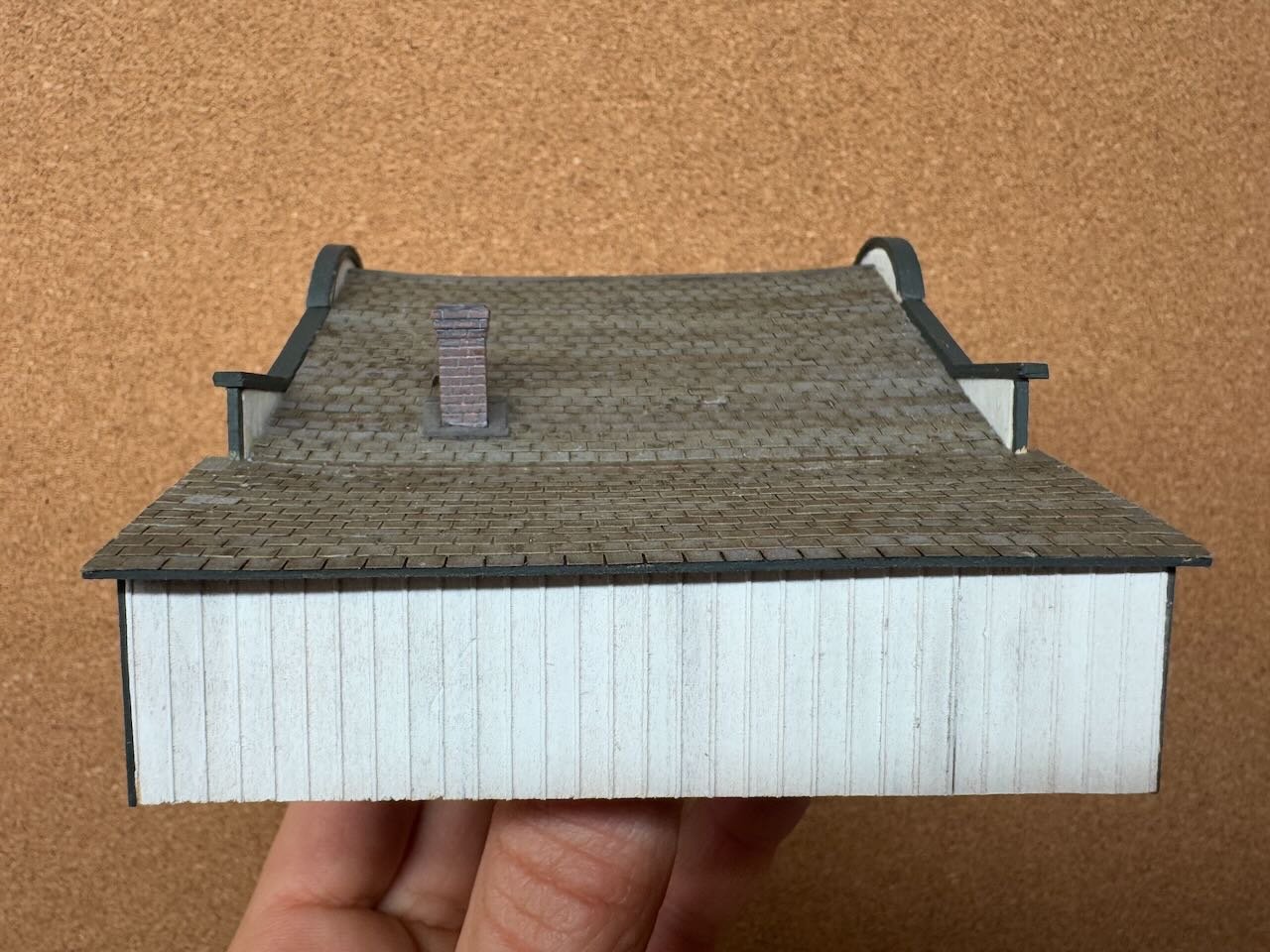
And a final shot of the interior, showing the internal structure and bracing.
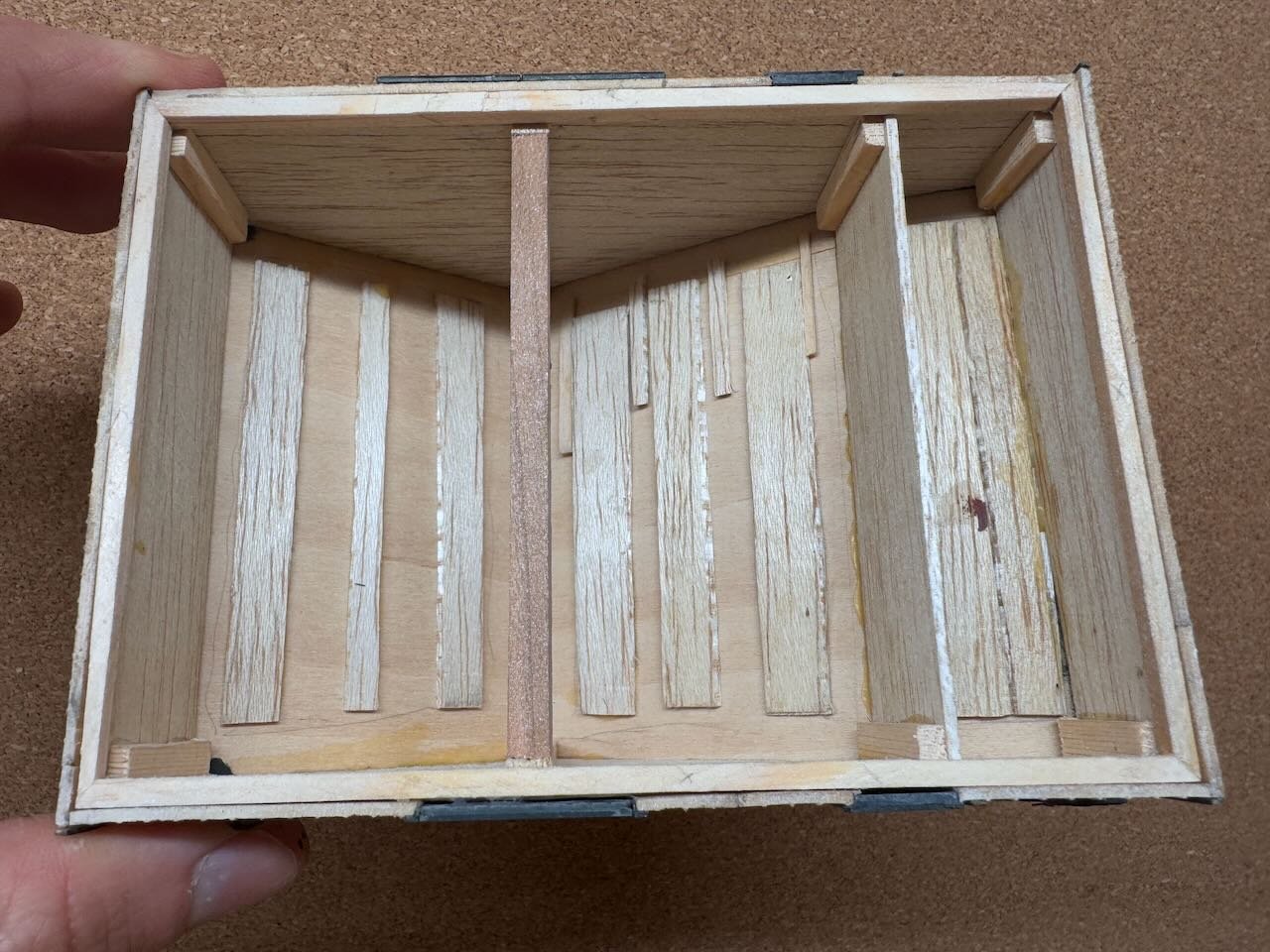
And now to place it on the layout. Here's two views in its intended setting, though without any attempt to blend in the base.
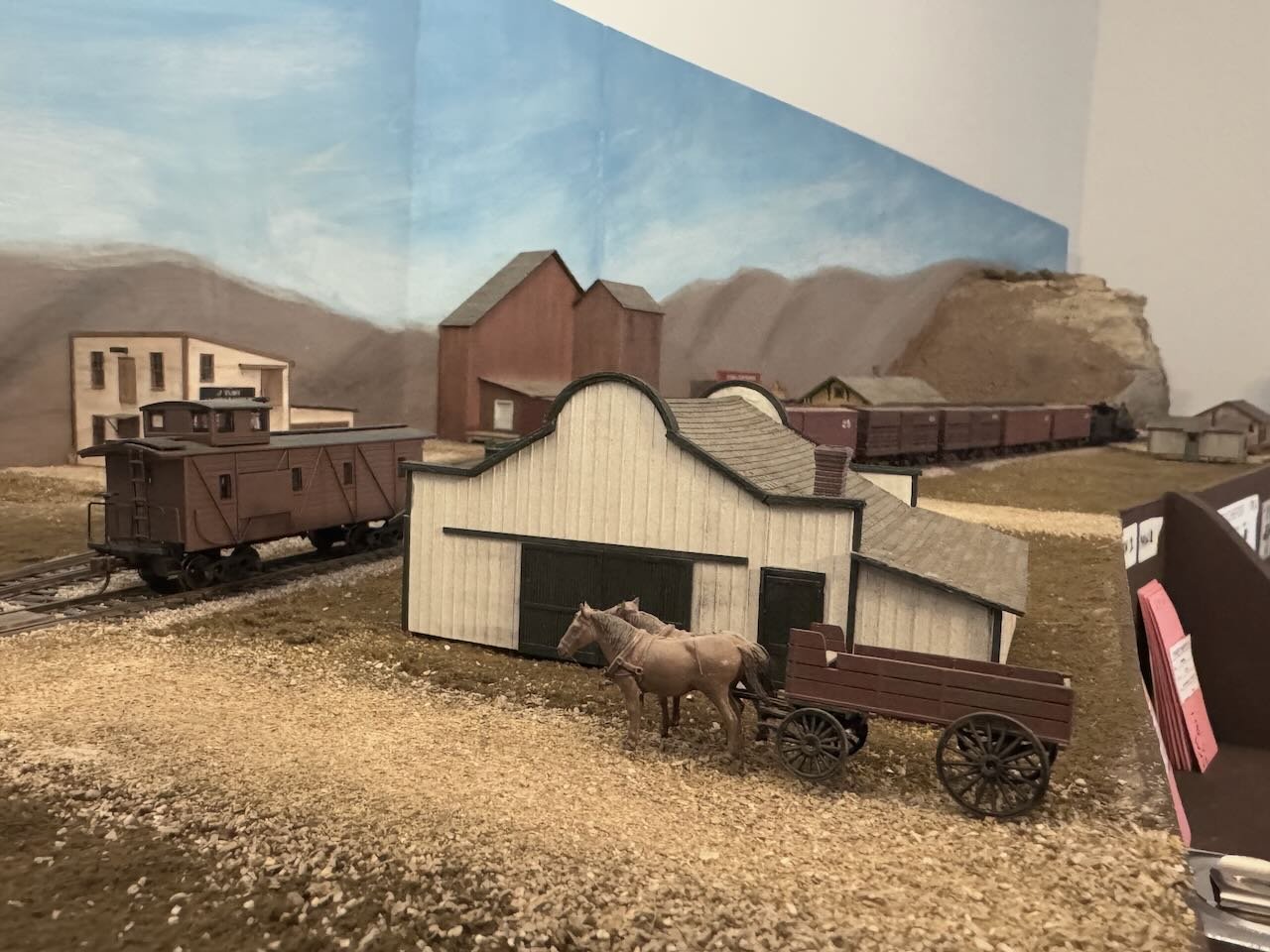
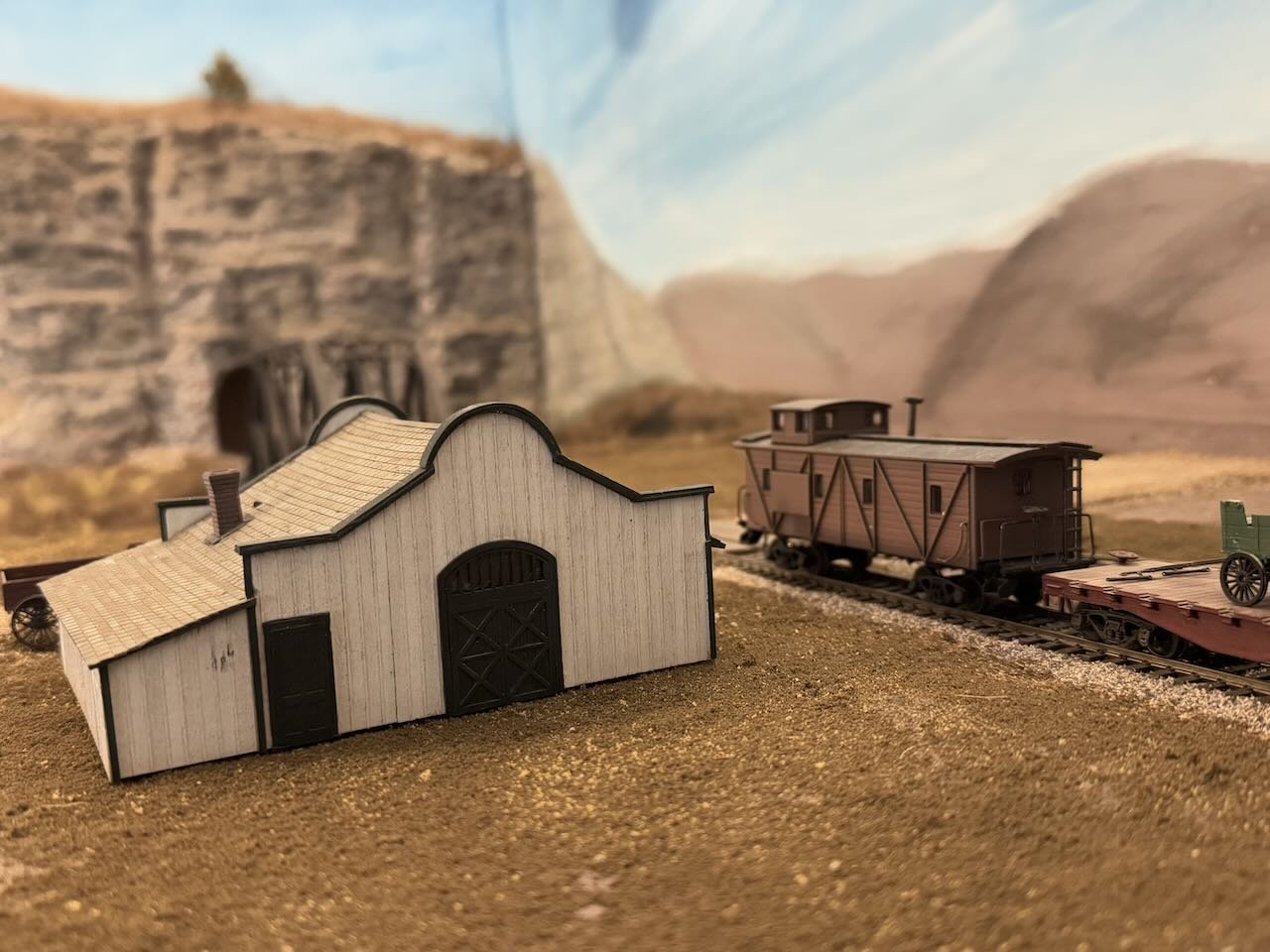
And for the full context, here's the model in place and the historic photo:
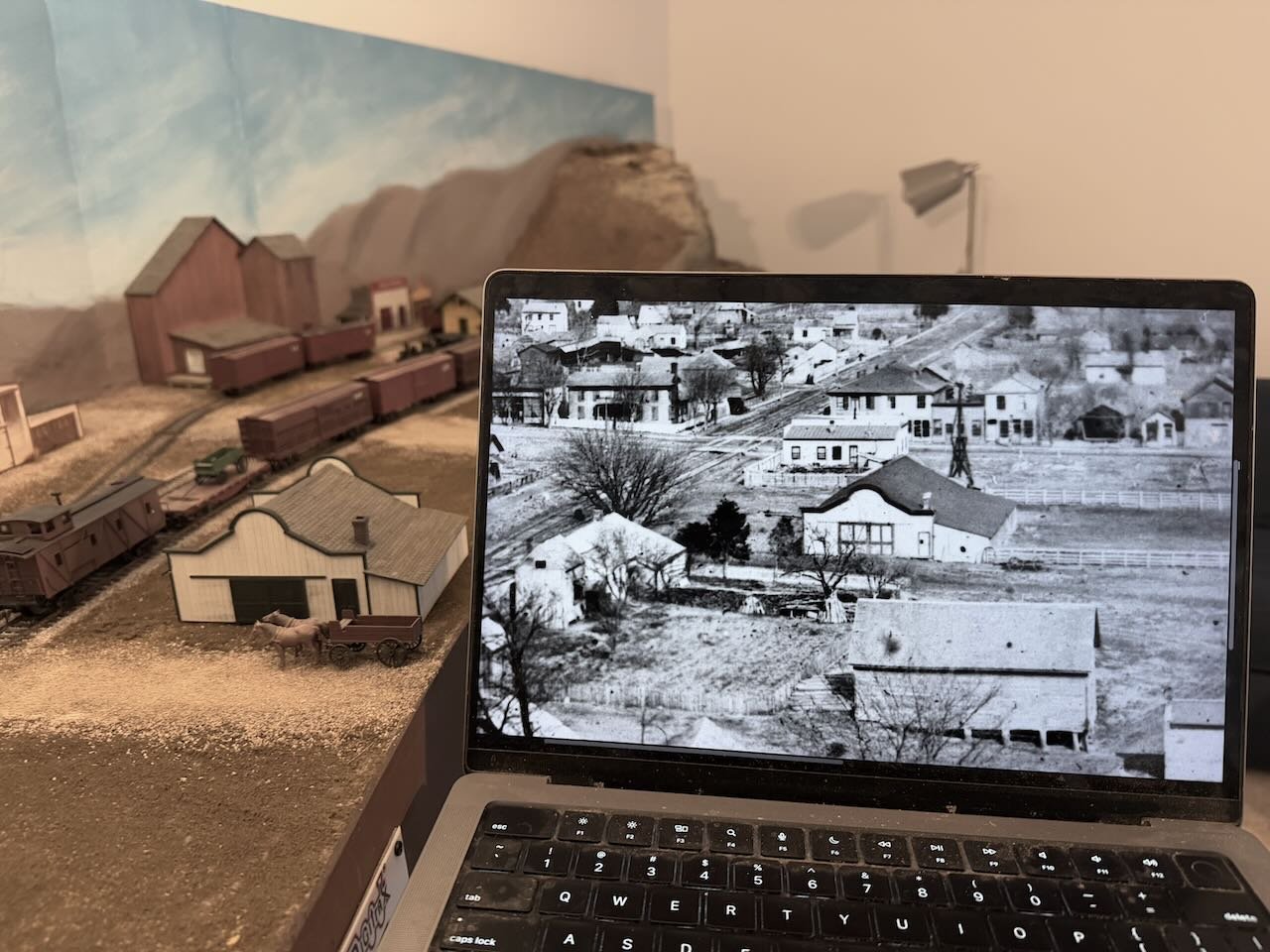
The biggest difference is the color of the doors: I tried painting them with the internal panels but just couldn't get the borders clean enough, so decided that solid-color doors were fine with me. Better "wrong" than "looks wrong".
The barn is low enough to work as a foreground structure, not getting in the way of reaching the tracks during operation. And it's just such an attractive and distinctive building! I have to say, I'm really pleased with how this came out. Very happy with it. I hope you are too!
-
I definitely like how the tricky wheel wells came out.
Did you ever try those dry transfer letters you mentioned ordering?
- tmj, thibaultron, Keith Black and 3 others
-
 5
5
-
 1
1
-
That's glorious. I always dreamed of doing a full steamboat interior like that and never have yet. Such a great job bringing this area to life.
-
That followup zoomed in photo means I could go either way on the fabric vs board debate. Either is believable as a method used on the real thing. There's definitely distortion in the photo itself but other aspects of that view do imply fabric. Whatever Keith decides on this one will make sense and look right.
- kurtvd19, Keith Black, thibaultron and 2 others
-
 4
4
-
 1
1
-
10 hours ago, Glen McGuire said:
I'm also wondering what causes those wrinkles near the top.
Pretty sure those are in the photo itself. You can see the wrinkles extending up from the sign, over the bridge pier and bridge.
EDIT: I posted on Page 6 without noting that discussion continued on to Page 7. I agreed with Kurt that it really looks like it's painted over boards, but I haven't done the exhaustive close-up looks Keith has. Are you certain that the tacks you see aren't nailed attaching the boards to inner framing? It would look much the same.
- Paul Le Wol, Glen McGuire, KeithAug and 2 others
-
 4
4
-
 1
1
-
That's what a goat is for. Fresh milk for the pantry, too. I'll stop dragging this off-thread now.
- Keith Black, tmj, MAGIC's Craig and 1 other
-
 1
1
-
 3
3
-
So does the steward install temporary real turf when a VIP books a room?
-
Looks amazing! Though I have to admit, the Astroturf bed made me laugh.
-
Sorry, Keith, I missed that you'd said that already.
Also, an idea occurs to me. I have a sheet of printed signs left over from the last model railroad building project mentioned on my log. They're on cardstock and quite nice. I could easily slip some of these into an envelope to you if you wanted a few of them for this project. I could see doing some window coverings as plain and a few as signs just to add to the creative quirkiness, since we're none of us sure exactly what he used. Wouldn't cost more than an envelope and a stamp. Here's what the sheet looks like, most of these would be appropriate for the 1930s:
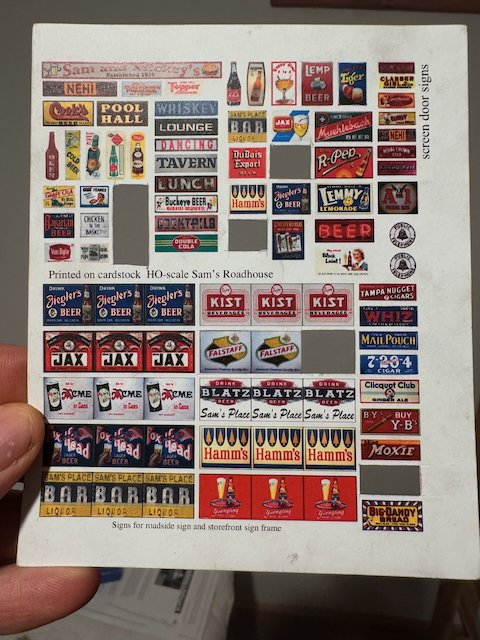
-
Honestly I don't see anything that looks like signs. The patterning looks like anything from curtains to plywood to cardboard, with arguably the distorting effect of refraction in glass in a blurry image.
As for lettering the stern, have you considered dry transfer letters? They're straightforward to use, though require careful alignment as you have to do each one separately. But you're no stranger to careful small-scale work. Most come in sheets of all letters, which can be annoying, but in your case that means you have lots of spare letters to experiment with before using your precious B-I-L-L-Y. Woodland Scenics makes a wide variety of different fonts. Same things I used to letter the storefronts in my railroad build.
- thibaultron, Keith Black, Canute and 2 others
-
 4
4
-
 1
1
-
Keith, on the houseboat/barge, aren't those windows?
-
Carrying more anchors than usual as a survey ship makes sense. But is that really where they stowed them? Seems like asking for hull damage and anchor loss, as well as harder to handle. I guess it's not easy to maneuver a large anchor out of the hold or something, either?
-
Maybe I'm wrong, but that seems like a mistake by Occre. Yes, someone could bend a heavy line to that anchor before dropping it, but notice there's no cathead or other setup for launching or recovering that anchor without damaging the hull. And having it hanging there, not properly catted, also sounds like a recipe for damage. Finally, I don't think she would have carried four full-size anchors like that. But to be fair I'm not an expert on Beagle.
-
52 minutes ago, Balclutha75 said:
Are you going to the KRHS convention in Kansas City beginning on April 29?
I'm a member and have every intention of doing so! The one in St. Louis two years ago was great. Last year's was in Texas and I had a family conflict with traveling that far. KRHS site definitely has some nice resources, though most are a bit too modern for my era. The State Historical Society of Missouri has quite a bit of useful material both online and in their physical research center, which isn't that far from me.
54 minutes ago, Balclutha75 said:Somehow it's weirdly gratifying to know that masters of the art also do things like this. ☺️
And non-masters like me as well!
- Canute, Jack12477, Old Collingwood and 2 others
-
 5
5
-
Ken, I find that the story-telling aspect of model railroading is very appealing to the historian and writer in me. Obviously every model can tell a story, but there's something particularly rich in designing and implementing an entire setting, beyond just a stand-alone item. I'm really enjoying how this town is coming together and I look forward to expanding the layout, probably early next year.
And thanks to Keith and all the other supporters!
- Keith Black, Old Collingwood, Canute and 1 other
-
 3
3
-
 1
1
-
Another building for you. This is the other "wrong side of the tracks" structure, where the land starts sloping down toward the river and incomes and property values are lower. Intended as a general tavern / store kind of place. You can see the kit's version here: https://www.blairline.com/samsroadhouse/ No photos of construction, because it's a pretty straightforward laser-cut kit and I didn't do anything particularly unique to it. Just some basic weathering.
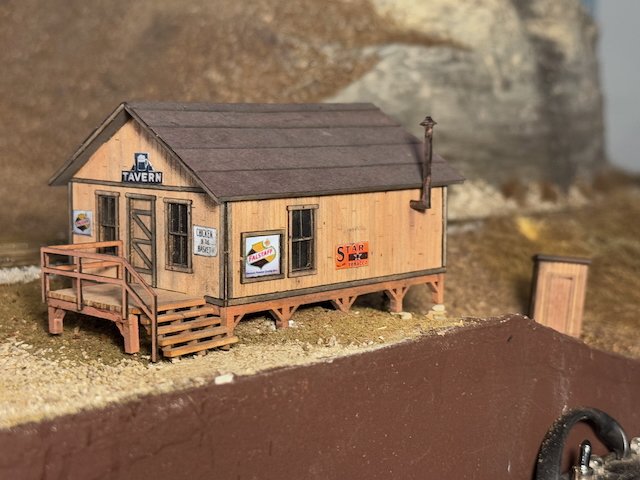
I didn't use the kit's corrugated metal roofing (see link above), preferring tar paper. Although metal roofing was in use by 1900, my sense is it was far from ubiquitous. I don't have any other buildings I intended to use metal roofing on, and it'd look strange for the only building with such a new-fangled idea to be one of the rougher settings. I also didn't want a super-rusty look as even in the rougher part of town, I want Rocheport to have a well-kept appearance, and I wanted this to look like a relatively recent construction, not a 50-year-old wreck.
Notice the outhouse downhill in the back, that was part of the kit. Also part of the kit was a sheet of possible signs. I chose a couple brands that really were produced in St. Louis during this era, Falstaff beer and Star tobacco. The manufacturer's version has this building plastered with signs, but I think that's overkill clutter and like how just a few add some flair while letting the building breathe overall.
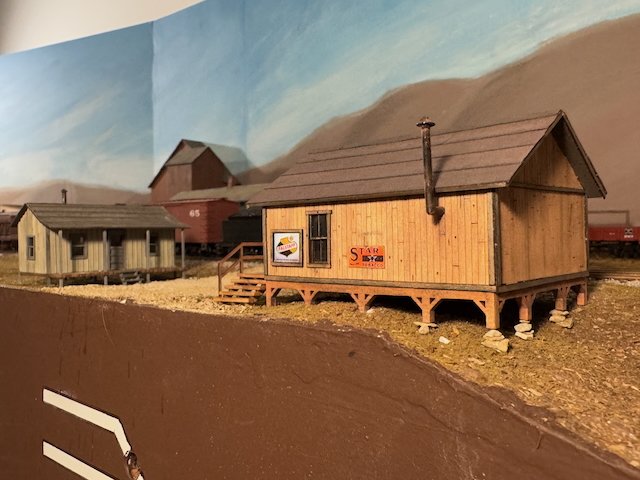
I intentionally chose this one and its partner across the street because they're up on posts, as is common for river-adjacent structures in this region. I used small pieces of crushed limestone to build up support pillars for the wooden posts. This is also pretty common around here in older buildings. Close eyes will notice in the first photo that I need to stick a couple rocks under the front porch posts. I like how this sticks out over the slope that starts descending down to the river.
No paint on this one, it's all pastel weathering. I really wanted this to have a raw-wood look to it. The lower supports are intentionally more reddish to hint that maybe they were built from local Eastern Red Cedar, which is highly rot resistant and very common around here. I've built all of my full-scale outbuildings from it, and it would have been quite easy for someone to harvest in 1900, too. I think the raw wood goes well with the subtle grey of the sharecropper house, and contrasts with the brighter colors of the depot area.
And here's a broader view, showing how this frames the street leading from the river landing into town past the east side of the depot. That's the last building for this district; other than trees, other vegetation, and some fencing, that's pretty much how this is intended to look.
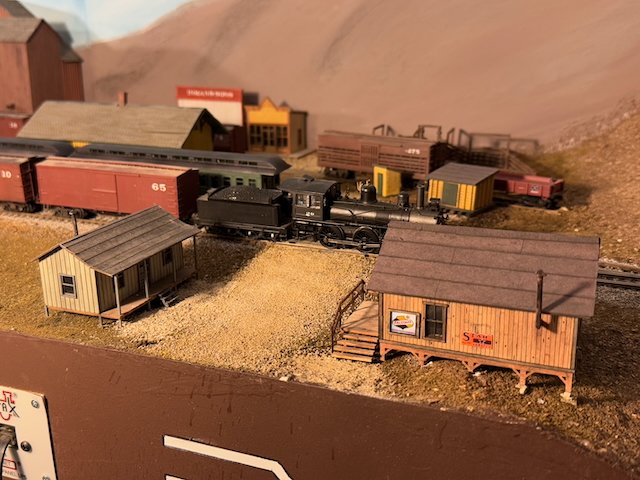
Thanks for following along!
-
I agree with you on the satisfaction from the craftsmanship of building the boats yourself. Nice job!
-
Lovely photo! That girder, and those doors, especially look like equipment access to me, the way they've lined up vertically with a hoist-support beam above. This was how machinery was hoisted up and into various floors in many buildings.
Here's a classic older example from Missouri, at Watkins Woolen Mill State Park (from the park's photo gallery, though I've been there many times). Look at the vertical line of access doors, overhung by a roof extension that housed support beams for whatever pulley system was used to hoist machinery to all the mill's different floors.
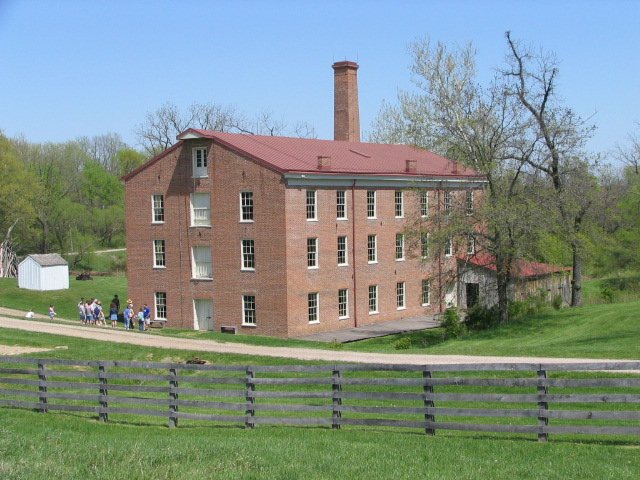
As discussed earlier, the commentariat convinced me that my elevator's doors weren't equipment access given the way they're not lined up and don't have any hoist housing above them. But the style of access door shown above is super-common in mills and similar industrial buildings and it's worth recognizing.
So glad to have you following along!
- GrandpaPhil, Keith Black, Canute and 4 others
-
 7
7
-
Thanks for joining us! Better late than later. I do much enjoy all the different complex directions model railroading takes one, mentally and artistically. Ship building does too, just in a different way.
- Jack12477, Keith Black and Canute
-
 3
3



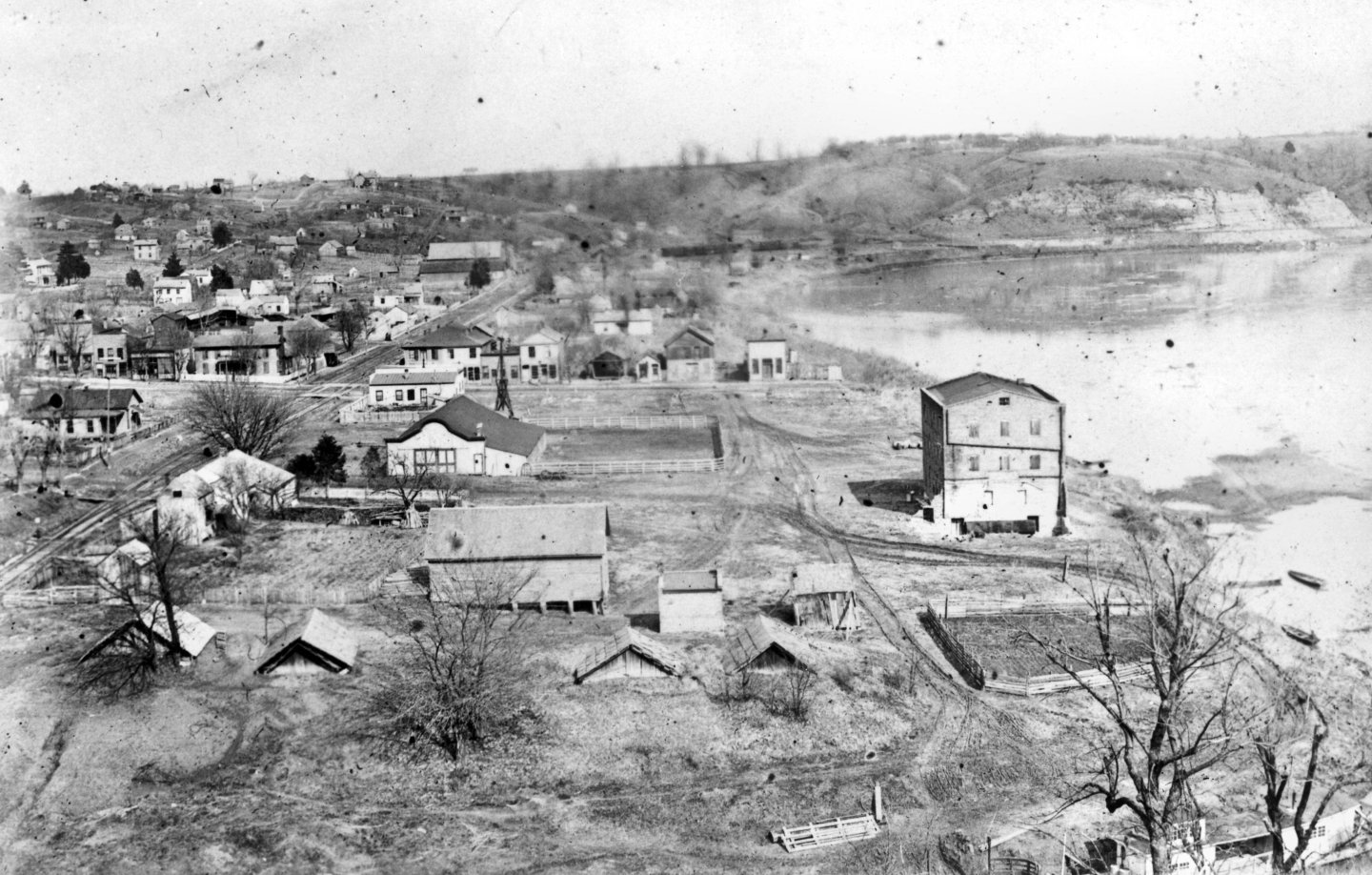
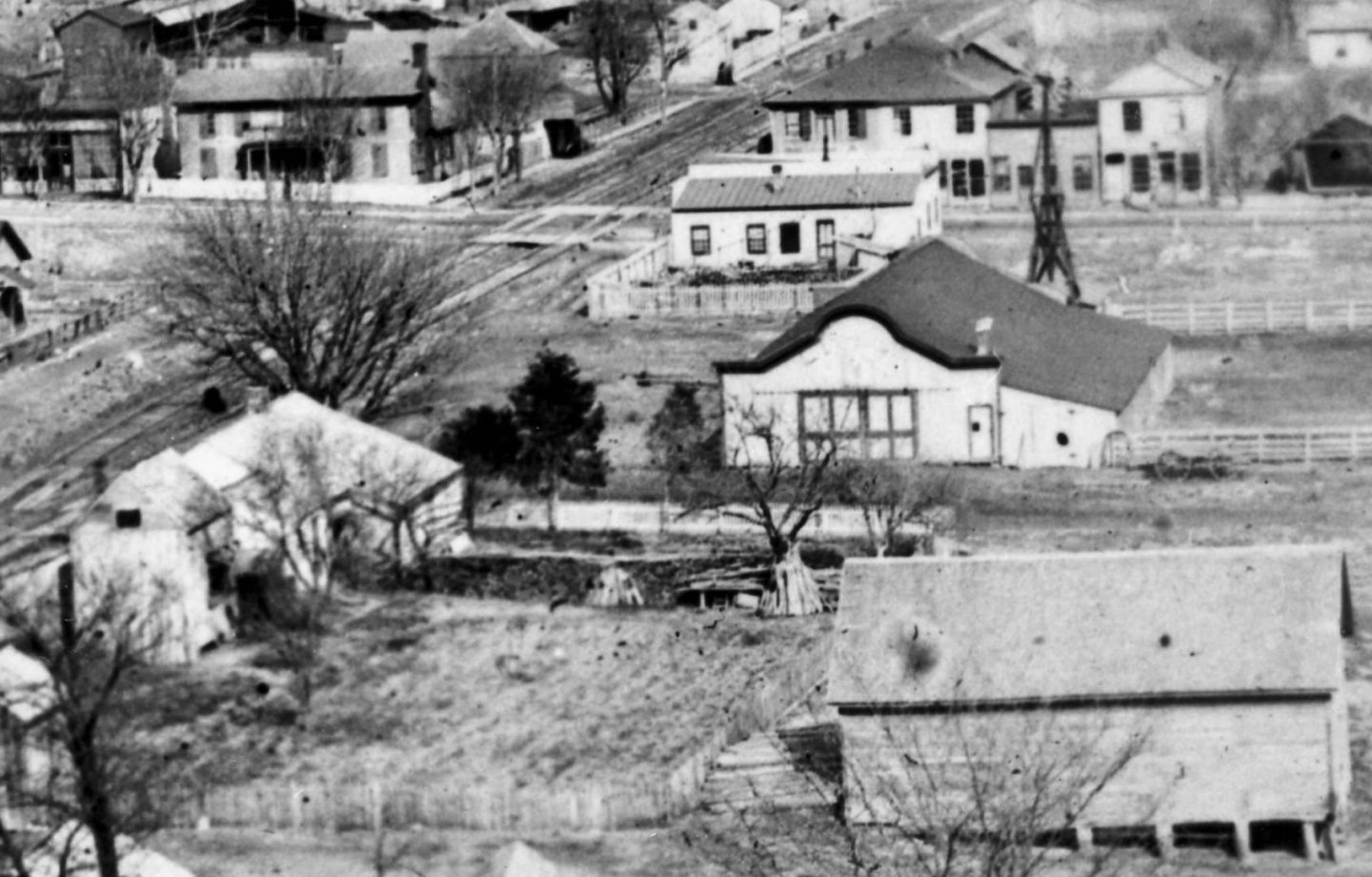

Missouri, Kansas, & Texas Railroad along the Missouri River by Cathead - 1/87 (HO) scale - model railroad with steamboat
in Non-ship/categorised builds
Posted
Thanks to both of you for your enthusiastic interest in figuring out more about the barn's history and use! Discussions are useful even when I stick to my guns. And I very much appreciate the ongoing interest and curiosity this project generates.